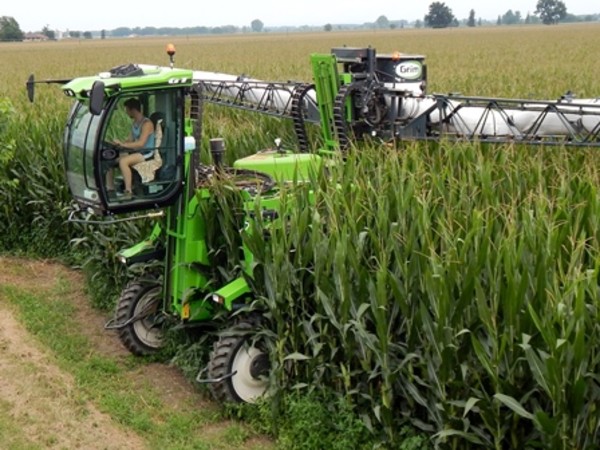
Self-propelled sprayers for herbaceous crops
Self-propelled sprayers are machines especially adapted for extensive croplands and are show interesting prospects for development also in Italy where manufacturers have come out with models well suited for various operational requirements to join those produced by major multinationals
European bans on neonicotinoid pesticides resulting in more or less unavoidable recourse to post-emergence maize treatment has led to the revival on the market of self-propelled sprayers with row-straddling booms, so-called trampolines. This is a matter of a special means which differs fairly sharply from the classic self-propelled sprayer equipped with a sprayer boom used for a long time especially in limited area of extended croplands.
In fact traditional self-propelled machines feature fixed ground clearance, usually between about one to two meters, whereas thanks to large dedicated hydraulic cylinders for trampolines the variation in height can reach three meters, starting from very low ground clearance. This means ground clearance can be regulated up and down with no need for the operator to climb down from the drivers seat to do so.
Among other points, the market could soon be given a substantial boost for both type of machine with passage into law of the European Union Directive on the sustainable use of plant treatment products leading on to the need for the renewal of a considerable part of the traditional machinery invention. Many farmers could decide to scrap their present machine because it would not be economic to bring it up to compliance with the new norms. In these cases, there could be a significant increase in recourse to contractors for carrying out plant treatment, not only because of technical considerations alone but especially for bureaucratic reasons related to authorization for the purchase and use of plant treatment products, increasingly complicated to get.
Also to be taken into account is that precise and perfect plant treatment cannot be performed without a vast store of knowledge – recognizing with certainty the parasite, the weeds or the plant pathology, identifying the principle ingredients for combating them, knowing about the commercial formulas available on the market and then the best technique for applying them, etc – so it is easy to understand that recourse to contractors specialized in crop defense has expanded greatly over a short period. For carrying out these treatments agri-mechanical enterprises prefer self-propelled models because of their great advantages over traditional sprayer booms, mounted or trailed by the tractor. Above all, the self-propelled machines are almost always equipped with wheel suspensions which are usually hydro-pneumatic for ensuring not only a comfortable ride for the operator but also greater boom stability at work to speed up the job by up to double that of conventional machines and boost productivity.
Work capacity without equal
Even without considering the impressive world record for productivity chalked up by the SpraCoup sprayer treating as much as 102.6 hectares in one hour and 15 minutes, distributing a dose of mix of only 16 l/ha at speeds of 28 to 37 km/h, it must be emphasized that these mounted sprayers with a standard 24 to 36 m boom can operate on land which has been properly levelled at 15 to 25 km/h with good results. Moreover, low volume treatment of less than even 100 l/ha can be performed with what are now the common air sleeves in use for reducing drift and ground loss. Mounting typical tanks with 3000-4000 l capacities rounds out the picture to guarantee operational capability greatly beyond that of traditional machines coupled with tractors.
Big but agile
Within broad limits, it is almost always possible to have a rapid variation in wheel tracking; moreover, other than standard steering with the two front wheels there are options for integral four-wheel steering as well as for crab steering. The locations of the mix and diesel tanks and the engine are such to maintain a distribution of load on the wheels as equal as possible.
The possible disadvantage, perhaps the only one, of self-propelled boom sprayers over traditional models is that recourse to integral hydrostatic drive is less powerful than the mechanical transmissions of most tractors. Aside from work performance, this usually means higher fuel consumption which is, however, offset by less time for operations and less resistance to moving forward due to the larger tires mounted.
A great selection of tires
Ranges of wheels and tires are ample. Wide tread tires are available for lowering compaction and are optimum for operations on soft and/or wet terrain which, for example, might be the case for the winter treatment of wheat or barley or spring work on summer crops. In any case, for cultivations beginning to emerge it is required to mount traditional narrow tread tires. In this connection, some tire manufacturers have recently brought to the market traditional narrow tires with extremely flexible carcasses which can run with inflation pressures well below those for traditional tires to provide the advantage of low compaction. This benefit is not gained by extending tread width rather by a longer contact surface due to a larger wheel diameter with rims of up to 40”. In general, the scale of compaction is according to values similar to those obtained with a traditional tractor coupled with a trailed sprayer boom with the same fuel tank capacity.
Automatic satellite drive
Almost all self-propelled sprayers with saddle booms are equipped for the installation of modular satellite drive for performing so-called parallel driving. Management precision is down to the ten-centimeter scale – completely free with a GPS signal or for a fee for the correction of the signal if there is no fixed ground station on the land – and down to the centimeter scale with an RTK device which reduces errors to a minimum. The level of automation also independently controls the opening and folding of the single sections of the boom as well was the individual nozzles for treatment on irregularly shaped fields to avoid damage caused by overlapping and/or the opposite, leaving areas not treated.
What the market offers
Though consideration can be given to the merits of the foreign majors at work in the sector for a long time, including John Deere and AGCO (which features the Challenger trademark) and Hardi and Amazone in Europe, it should also be reported that for some time Italian manufacturers have gained distinction in this niche sector with machines which are not only of excellent quality but are brought to the market with competitive prices. Among other points, these domestic companies ensure greater flexibility for the configuration of their machines. This is greatly appreciated by end-users who often have special requirements associated with specific farming models and traditions on their holdings.
With no intention to provide through coverage here, the domestic producers of self-propelled sprayer booms are, in alphabetical order, Caffini in Palù (Verona), De Cloet in Città di Castello, Finotto in Ceggia (Venice), now in the Maschio Gaspardo Group, Grim and Rimeco (marketed also under the Bargam brand name) both in Jesi, Mazzotti in Ravenna and Spapperi in San Secondo (Perugia), which also markets machinery for tobacco crops produced by Toselli di S. Giovanni in Persiceto (Bologna).








